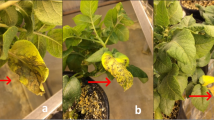Abstract
The genetic basis of virulence of 24 isolates of L. maculans collected from various sites throughout south-eastern and south-western Australia were studied using five clone-lines of B. napus. The experimental design allowed the estimation of the environmental and genetic components of variance using a standard analysis of variance. Virulence of these isolates (as measured by the percentage of stem girdling, %G) on the clonelines NCII and Tap was found to be most likely controlled by a small number of genes; the broad-sense heritabilities were 79.7% and 67.5% for virulence on NCII and Tap, respectively. The significance of these results in relation to the potential of L. maculans in adapting to new resistant B. napus cultivars is discussed.
Similar content being viewed by others
References
Ballinger DJ, Salisbury PA (1989) Effectiveness of selection for seedling resistance to blackleg in rapeseed. In: Proc 7th Aust Rapeseed Agron Breed Workshop. Toowoomba, pp 86–89
Ballinger DJ, Salisbury PA, Kadkol GP (1991) Race variability in Leptosphaeria maculans and the implications for resistance breeding in Australia. In: Proc 8th Aust Res Assembly Brassicas. Horsham, Victoria, pp 99–104
Bonman JM, Gabrielson RL, Williams PH, Delwiche PA (1981) Virulence of Phoma lingam on cabbage. Plant Dis 65:865–867
Burnett JH (1975) Mycogenetics: an introduction to the general genetics of fungi. John Wiley & Sons, London New York Sydney Toronto, pp 127–147
Burton GW, DeVane EH (1953) Estimating heritability in tall fescue (Festuca arundinacea) from replicated clonal material. Agron J 45:478–481
Cargeeg LA, Thurling N (1980) Contribution of host-pathogen interactions to the expression of the blackleg disease of spring rape (Brassica napus L.) caused by Leptosphaeria maculans (Desm.) Ces. et De Not. Euphytica 29:465–476
Comstock RE, Kelleher T, Morrow EB (1958) Genetic variation in an asexual species, the garden strawberry. Genetics 43:634–646
Cooper JP (1959) Selection and population structure in Lolium. Heredity 13:445–459
Croft JH, Simchen G (1965) Natural variation among monokaryons of Collybia velutipes. Am Nat 94:451–462
Downey RK, Klassen AJ, Stringen GR (1980) Rapeseed and mustard. In: Fehr WR, Hadley HH (eds) Hybridization of crop plants. Am Soc Agron Crop Sci Soc Am, Washington, D. C., pp 495–509
Foster GS, Shaw DV (1988) Using clonal replicates to explore genetic variation in a perennial plant species. Theor Appl Genet 76:788–794
Humpherson-Jones FM (1983) Pathogenicity studies on isolates of Letosphaeria maculans from Brassica seed production crops in south-eastern England. Ann Appl Biol 103:37–44
Humpherson-Jones FM (1986) The occurence of virulent pathotypes of Leptosphaeria maculans in Brassica seed crops in England. Plant Pathol 35:224–231
Johnson RD, Lewis BG (1990) DNA polymorphism in Leptosphaeria Maculans. Physiol Mol Plant Pathol 37:417–424
Koch E, Song K, Osborn TC, Williams PH (1991) Relationship between pathogenicity and phylogeny based on restriction fragment length polymorphism in Leptosphaeria maculans. Mol Plant-Microbe Interactions 4:341–349
Larkin PJ, Scowcroft WR (1981) Somaclonal variation — a novel source of variability from cell cultures for plant improvement. Theor Appl Genet 60:197–214
Libby WJ (1962) Estimation of variance components of internode length in a clonal population of Mimulus guttatus. Genetics 47:769–777
Libby WJ, Jund E (1962) Variance associated with cloning. Heredity 17:533–540
Mather K, Jinks JL (1971) Biometrical genetics: the study of continuous variation, 2nd edn. Chapman and Hall, London
McGee DC, Petrie GA (1978) Variability of Leptosphaeria maculans in relation to blackleg of oilseed rape. Phytopathology 68:625–630
Murashige T, Skoog F (1962) A revised medium for rapid growth and bioassays with tobacco tissue cultures. Physiol Plant 15:473–497
Newman PL (1984a) Differential host-parasite interactions between oilseed rape and Leptosphaeria maculans, the causal fungus of stem canker. Plant Pathol 33:205–210
Newman PL (1984b) Screening for disease resistance in winter oil-seed rape. In: Aspects of applied biology 6: agronomy, physiology, plant breeding and crop protection of oilseed rape, pp 371–380
Plummer KM, Dunse K, Howlett BJ (1994) Non-aggressive strains of the blackleg fungus, Leptosphaeria maculans, are present in Australia and can be distinguished from aggressive strains by molecular analysis. Aust J Bot 42:1–8
Simchen G (1965) Monokaryotic variation and haploid selection in Schizophyllum commune. Heredity 21:241–263
Snedecor GW, Cochran WG (1989) Statistical methods, 8th Edn. Iowa University Press, Ames, Iowa
Author information
Authors and Affiliations
Additional information
Communicated by G. Wenzel
Rights and permissions
About this article
Cite this article
Pang, E.C.K., Halloran, G.M. Genetics of virulence in Leptosphaeria maculans (Desm.) Ces. et De Not., the cause of blackleg in rapeseed (Brassica napus L.). Theoret. Appl. Genetics 93, 301–306 (1996). https://doi.org/10.1007/BF00223169
Received:
Accepted:
Issue Date:
DOI: https://doi.org/10.1007/BF00223169




